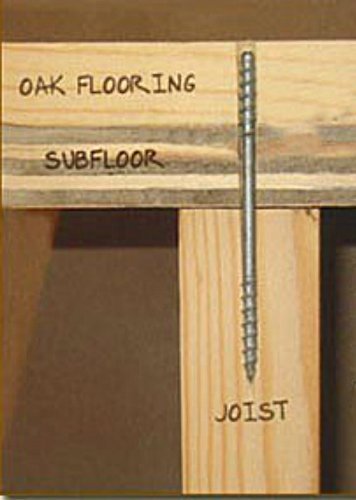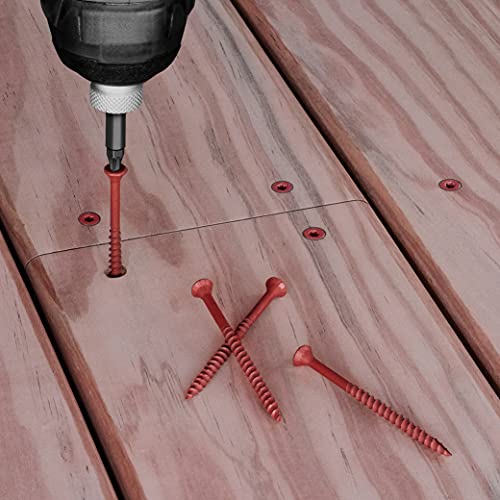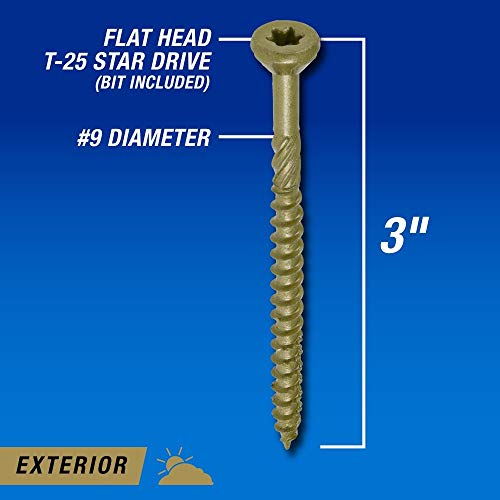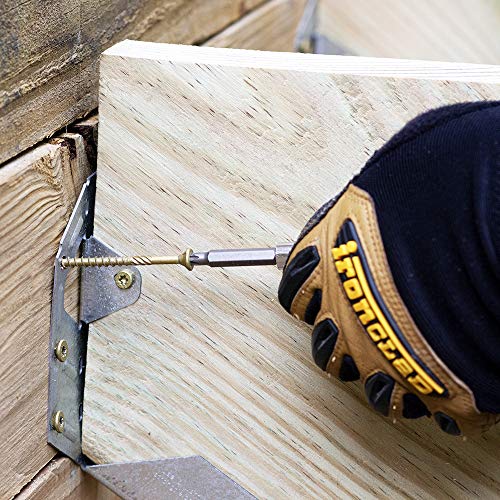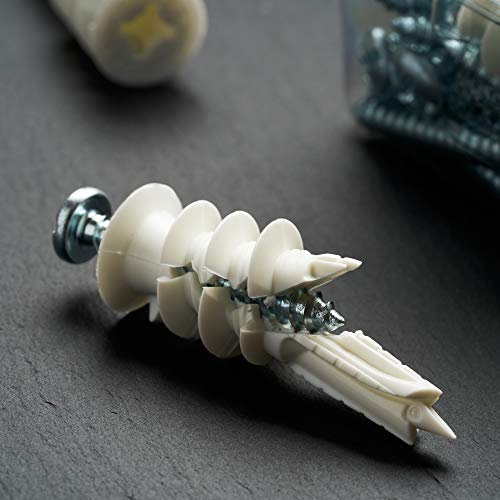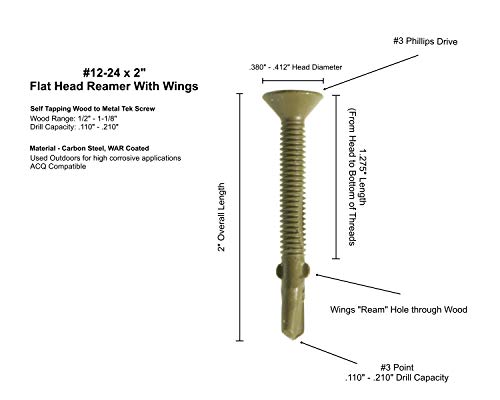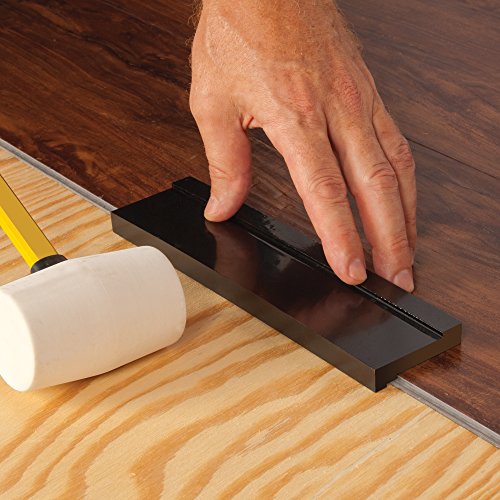You don’t need to deal with squeaky floors any longer. There are measures you can take to make sure those annoying problem boards are no longer an issue.
Screws have proven to be one of the best fasteners to deal with squeaky floors. We know the specific screws that are perfect for the job, and once you’ve read through this article, you will too!

Screws are better than nails to silence squeaky floors. 1¾”-3” subfloor or flooring screws are best. Deck screws and construction screws are also adequate. Steel and galvanized steel are the best materials. #8 to #12 sized screws are the best thickness. Fine threads create tight holds in but are slow to install.
Screws or Nails? Which Are Best?
For installation of subfloors, nails and screws both work, but each comes with its own benefits and drawbacks. In terms of squeaking, or rather, the prevention thereof, screws have proven to be the best option.
Nails are the faster option since a nail gun works faster than a drill. They are also cheaper than screws. However, nails have more potential for squeaking than screws. With temperature changes, nails can cause squeaking due to movement between the subfloor and the nail. This is especially true in areas of high traffic flow.
The speed and inexpensiveness of nails is often very tempting to an overextended or sub-par contractor, so make sure you know what’s happening with the installation of your wooden flooring.
If your contractor has tried to cut corners and the result is a squeaking floor, then unless you signed a contract that specifically excludes fixing squeaking floors, then this problem should be covered under your warranty.
Screws take longer overall since they need to be twisted into place and are often more expensive than nails. But screws are better for preventing squeaking since they are less likely to loosen and have movement. Screws are solidly drilled into place and the threads help hold them where they are.
Subfloor vs Top Floor Screws (Is There a Difference?)
Subfloor screws differ from top floor screws because the top floor screws’ heads will be visible. Top floor screws also need to be somewhat longer than subfloor screws because they need to drill down through the floor, subfloor, and into the joist below.
Make sure that top floor screws are longer than the length of the subfloor screw; that is an inch longer than the subfloor’s thickness, plus the thickness of the flooring above. Installation of a top floor screw might involve cutting a hole in carpeting.
The head of the top floor screw will be visible, so it is wise to choose a style of screw that is discrete or attractive. Certain types of screws come with removable heads, but these are inadvisable since they are not as strong as regular screws.
Best Screw Type
There are several types of screws that will work for subfloor installation and do a good job of preventing squeaking.
Subfloor/Flooring Screws
These screws are specifically designed to fasten subfloors securely and reduce squeaking. These screws are often 1 ¾” to 3″, which covers the length needed for most applications, and they are commonly covered in a zinc coating to resist corrosion.
These screws are made to be easily installed and will not split the wood they’re drilled into.
Deck Screws
Deck screws are often used for subfloor installation with great success. These screws have deep, sharp threads that create a tight hold in the materials. These screws are also sturdier than wood screws.
Deck screws are often made of stainless steel due to their common outdoor usage, and they run from about 1 ¾” to 3″.
Construction Screws
Construction screws can also be used for a subfloor due to their serrated threads, which allow you to use them without having to drill any holes first. Construction screws generally run larger than deck screws and other alternatives, with 3″ being among their lowest size options.
Don’t Use These Screws!
There are screws that are great to use, those that are sufficiently capable of serving the task, and then those that should be actively avoided.
Drywall Screws
It is inadvisable to use drywall screws on subflooring since they are not strong enough to handle the extensive impact on the floor. When used for flooring, the heads of drywall screws often bend or snap off under the pressure, while more durable options are built to withstand this strain.
Kits
Some sources do not advise the use of squeak prevention kits. Although these are a tempting, all-in-one option for fixing your squeaky floors, they are not durable enough to provide a lasting solution. If you want a quick temporary fix you can try talcum powder instead.
These kits usually come with tear-away screw heads, designed to hide screws in already finished flooring. But the problem with the kits is that they come loose once the screw heads are torn off.
Does the Material Make a Difference?
The best materials for subfloor screws are steel and galvanized steel. Both options provide the necessary strength and durability for the wear and tear of flooring.
Steel is the most suitable material for screws to prevent squeaking, since it is a stronger material than other screw types, including aluminum and brass. Galvanization gives steel screws the added benefit of being corrosion resistant by being coated with a protective zinc shell
Electroplated screws are suitable for indoor projects but will not weather well outside. The recommended screw material for outdoor projects is stainless steel.
There are several coatings other than zinc that can make screws more durable to withstand moisture and rust. Some of these different coatings include epoxy and HCR, or Highly Corrosion Resistant coating.
Screw Size
Ideal Diameter for the Screws
Screws should be thick enough in diameter to hold the subfloor securely. With increasing numbers corresponding to increasing diameter. #8-, #10-, and #12-sized screws will all work for subfloor installation.
For the strongest screws, a thicker diameter is recommended, thus, #12 screws are the strongest option for subfloor installation.
However, #8 is the standard size and will be effective for subfloor installation. This thickness is effective for most types of woods, and only heavier materials will necessitate a higher thickness. Screws thinner than #8 will likely not hold up well enough to work in the subfloor application.
Thick screws stand up well to up and down pressure (while longer screws are better for sideways force) like that of a foot stepping on the floor.
Choosing the Right Length of Screw
Length is the most important measure of screw size for making sure your floor is attached well and won’t squeak. If screws are not long enough, they will not be able to fulfill the job of securing the subfloor to the joist beneath it.
Screws need to extend about an inch past the plywood subfloor into the joist underneath it. Commonly, steel screws extend from about 1 ¼” to 3″ or more.
Most flooring experts will use 3″ screws for subfloor installation. This length will usually be at least as long as you will need, likely with some excess length since ¾” subfloor requires a 1 ¾” screw, a 5/8″ subfloor will require a 1 5/8″ screw, and so on.
What Type of Thread Creates the Tightest Join?
Screw threads come with variations that change how tight the screw is bound to the material. A screw with a finer thread will be a tighter bind than a screw with coarser threads.
Coarse threads mean fewer threads along the screw, while fine threads mean there are more threads along the length of the screw.
Possible downsides of fine threaded screws are their speed of installation. These screws are slower to install than coarse threaded screws. They are also less commonly used in applications. Coarse threaded screws are more commonly used even though they do not produce as tight of an application.
Thread sharpness and length are also factors to consider. Sharper, longer threads are able to attach more deeply to the wood and therefore make a stronger attachment.
Certain screws have a small thread near the head that allows you not to have to pre-drill a hole. An example of this type of screw is the Senco Duraspin, listed below.
Recommended Products
- Hard-to-Find Fastener Phillips Flat TwinFast Wood Screws (amazon link). These are inexpensive and have a long lifespan, making them perfect for beginners or DIYers. These screws are coated in an attractive, rust and water-resistant black phosphate finish.
- Senco Duraspin #8 Subfloor Collated Screw (amazon link). These Senco Duraspin screws are a great option since they are easy to install and have great staying power. They come with a yellow zinc coating resistant to rust and corrosion. They are ideally used in tandem with the Senco Duraspin screw gun to greatly increase the speed of the process.
- Hillman Group Square Drive Flooring Screw (amazon link). These Hillman Square Drive Flooring screws also boast being heavy-duty and easy-to-install options.
Silencing Squeaks Often Needs More Than Screws
If the joists are simply not level with the subfloor and gaps form between them, these gaps will likely cause squeaking. This problem cannot be remedied by simply adding more screws.
One way to quiet a chronically squeaking floorboard is to add a shim in between the floorboard and the subfloor where they have separated. A thin piece of wood should be covered in carpenter glue and inserted underneath the lifted subfloor. Make sure not to push the shim in too far, as this could cause even more of the subfloor to become lifted.
If squeaking is caused by a longer gap along the length of the floor joist, using a caulking gun to apply adhesive in the gap can be an effective method to silence the squeak.
If you have warped joists beneath your subfloor, this can cause gaps and squeaking. This problem can be remedied by installing long, level boards along the joists where they are warped and not touching the subfloor. This will give you a level surface to screw the subfloor into so there are no more gaps.
If your downstairs neighbor is complaining about squeaking floors, but the issues is not fixable with screws, you will have to make arrangements with them to gain access to the underside of the floor through their ceiling.
This is a tricky matter to navigate if your neighbor is on the unreasonable or frustrated side. However, there are some tips to approaching the situation, which I have laid out in my article: Downstairs Neighbor Complaining About Squeaky Floors.
Sources
https://www.nailgundepot.com/blog/installing-subfloors-nails-vs-screws.html
https://www.h2ouse.org/subfloor-screws/
DIY Squeaky Floor Fixes, You Should Avoid! (squeakknights.com)
https://toolsarchive.com/best-screws-for-subfloor/
https://www.hunker.com/12609071/the-differences-between-a-deck-screw-a-construction-screw
https://www.nord-lock.com/insights/bolting-tips/2010/choose-fine-or-coarse-thread-bolts/
https://www.angi.com/articles/how-silence-squeaking-floor.htm

